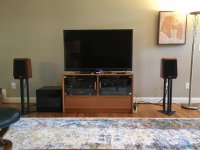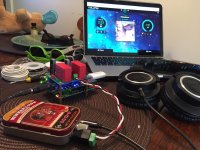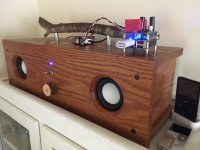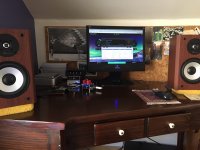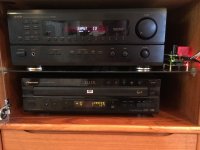yea its the 5 v in series that worries me the most been the lower end of the range of 2.5v
wonder in a floating situation can it be biased with resistors
I probably should stop hijacking Matt's thread lol.
Did some searching today, looks like rc and electric diy car guys have spent time working on ways to charge lifepo4 batteries, and there are ebay and cots solutions. Google balanced lifepo4 charger and you'll see lots of stuff out there.
But I think that a voltage reg connected to a transistor is the way to go here. Or I just make two isolated PS's.
Randy
You can just do this directly without using the earth pin of the Mac or monitor - just use a wire between that point & mains earth.
This seemed like the most obvious solution and it was the first thing I tried. Surprisingly, directly grounding did not help, and in fact seemed to making the buzz louder. I actually show this in the video. Although...I was using part of a pretty old and chintzy anti-static wrist strap for the task. I'll be embarrassed if I was just using a faulty ground wire the whole time...better try another to be sure.
This seemed like the most obvious solution and it was the first thing I tried. Surprisingly, directly grounding did not help, and in fact seemed to making the buzz louder. I actually show this in the video. Although...I was using part of a pretty old and chintzy anti-static wrist strap for the task. I'll be embarrassed if I was just using a faulty ground wire the whole time...better try another to be sure.
wrist straps have resistance built in, quite a bit, so discharge is slow.
is that output filter board transistor, mosfet or both?
The output filter's using bipolar transistors. Nothing much to stop anyone swapping the I/V transistor for a MOSFET, the pinout will be the same. MOSFETs have larger G-S threshold than a bipolar so the reference voltage fed to the base/gate needs reducing somewhat. I've been using SSM3J327R with good effect.
Yea, you want to provide a pathway to ground that is of lower impedance than the route the ground noise is currently taking so use a good wire (the bigger the gauge, the better) rather than anything else
wrist straps have resistance built in, quite a bit, so discharge is slow.
Bingo! I stole a real ground cable from another project and voila! I am going from the barrel of the iPower to mains earth, and the noise dropped by 95% (the original buzz is gone but now there is a teeny tiny bit of 60Hz hum). Perfectly acceptable low noise performance now! So I am sorry Matt, for raining on your parade as you unveiled your design - all due my ignorance.
I still have one nagging question that this whole misadventure has brought up. With a halfway decent ground wire, I can now get the get the exact same noise attenuation--without the 60Hz from mains--by simply plugging the ground wire into my Mac's power strip...when the power strip is NOT plugged into the wall! How in the world are these other PSUs completely eating the noise without a physical ground? Maybe they have CRC filters for this purpose or something? Might be worth trying to recreate this in line with my new ground wire.
Last edited:
What boost converter did you use? Anything special?
That would make it pretty simple, just need to change the 18650 cell with 3.3v and connect up the boost.
I was using one of these, don't know anything about the chip that's doing the boost other than its a 6pin SOT23 and seems to run about 1MHz or so. Needs quite aggressive filtering on its output not to cause strange noises....
18650???????5/6/9/12V????UPS??????????-???
You can get them in various voltages, or just tweak a resistor value to get what voltage you want. There's an in-built charger, just hook up a USB wall-wart, they sell the microUSB socket too.
OK, Matt, you asked for feedback...
I won't pretend to have used your 1387 DAC hat to the highest of its capabilities. Still, after listening to it in many sessions and through a handful of systems, I think I am ready to share some reasonably informed impressions of this DAC’s character.
All of my listening has been done with this DAC hat stacked on top of a RPi 3 and Allo Kali, all powered by a single iFi iPower SMPS. I have exclusively used Volumio to play my FLAC collection, which ranges from 16/44 to 26/192, from a USB thumb drive. In all cases, comparisons to other DACs were made with sighted A/B listening. Competing players were synced with identical music and volume matched by ear, both fed into a simple RCA source selector box for instantaneous switching back and forth.
I began by testing the DAC with headphones, since I do a lot of "canned" listening at night while my family is sleeping. Once I grounded the iPower barrel properly (thanks to you all for the hand-holding there) the noise disappeared, and I really fell in love with the sound of the 1387.
Signal chain was:
1387 Hat -> Pocket Class A Headamp -> both Audio Technica M50 and the Fostex T50RP Mk3 w/ Mayflower v1 mod.
IMO it is tougher to achieve a truly satisfying listening experience through headphones than it is through loudspeakers. They are fraught with driver and housing resonances that often color the sound more dramatically than speakers, and their soundstaging abilities are inherently limited by their unnatural placement directly on the head. That said, they eliminate room reflections and thus can offer a very revealing, direct window into the sound of a music source. This DAC has given me more listening pleasure through both of my pairs of headphones than any other source I have owned. It has a somewhat narrower soundstage than I am used to, and it presents a very cohesive center image which brings the music together into a dynamic whole, rather than splitting it apart. This sounds more natural to me, over headphones especially.
The 1387 has a gentle transient attack and a slightly warm but wonderfully nuanced midrange texture. It also has an innately relaxed treble that is not just the result of classic NOS rolloff at the 44.1 sample rate; this softness persists with files sampled up to 192 kHz. Since most headphones (mine included) tend to have glaring frequency response spikes in the treble region, this softness fights treble harshness better than anything else I have yet encountered, making the headphone listening experience infinitely less fatiguing, more organic, and downright pleasurable. Especially over my incisively fast, detailed, and slightly bright Fostex planars, this DAC smooths the sharp edges just enough, and brings a tonal richness that makes these cans sing absolutely gorgeously. For the first time ever, I can listen to entire an entire album through these headphones with satisfaction instead of fatigue.
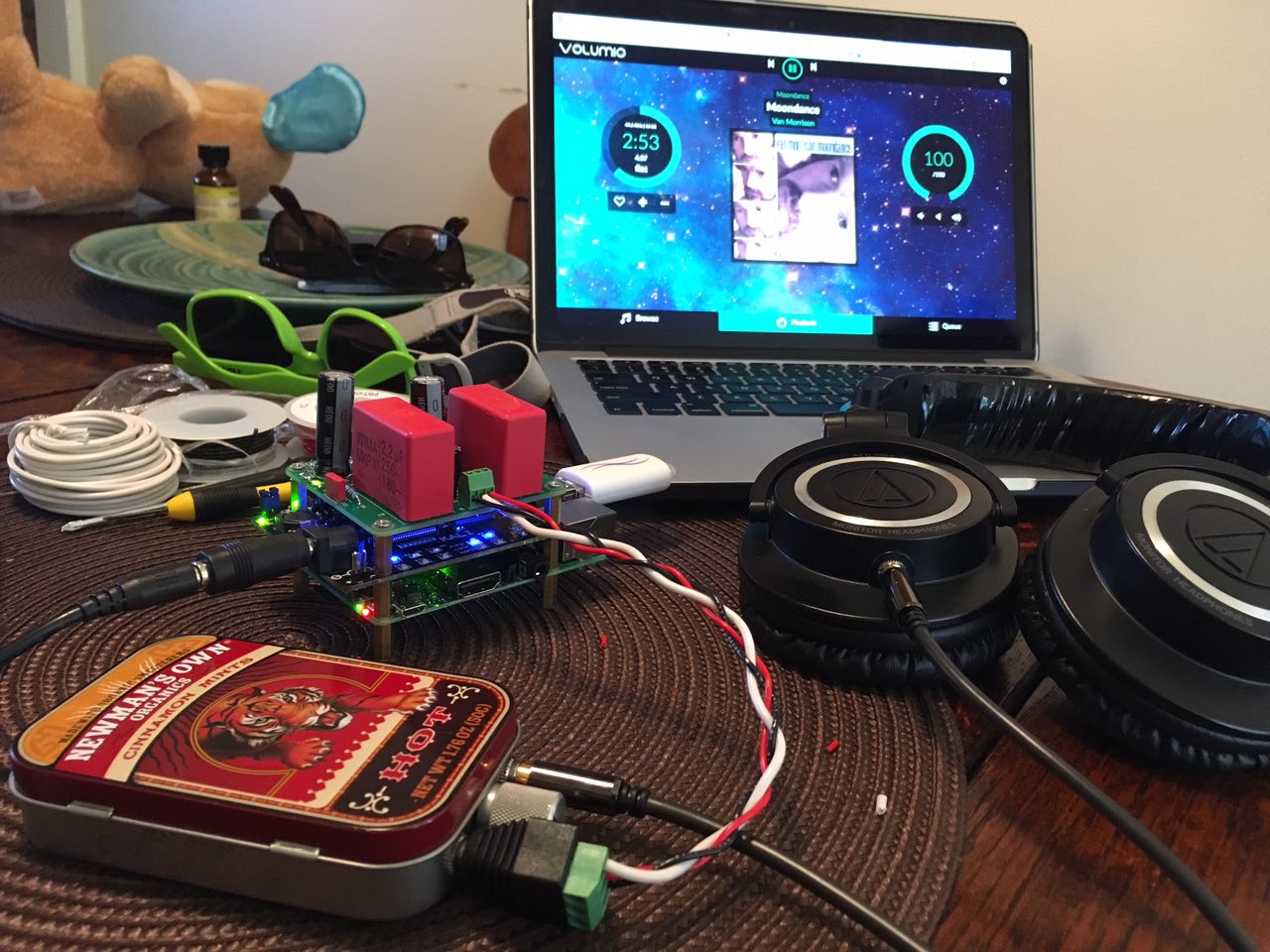
I also played this DAC over three speaker systems, both with and without my Pocket Class A in the chain as a humble but effective preamp. Since this DAC has a lowish output voltage, I believe it will shine brighter in any system when followed by a high quality dedicated preamp (better than the pocket amp I used).
Three signal chains:
Sure AA-AB32155 (Tripath TA2024) -> Aura NS3 full-rangers (my Carmody “Sprite” Boombox)
Topping TP-20 (Tripath TA2020) -> Axiom M3 bookshelf 2-ways (my nearfield desktop system)
Denon DRA-685 Class AB 100W integrated -> Opera Callas Gold bookshelf 2-ways w/ sub (my dad’s stereo)
Over speakers, the same gentle, pleasant sonic characteristics of the 1387 DAC persist, but may represent a step away from neutrality, towards more of a delicate sonic coloration, compared to most modern DACs (depending on the downstream equipment). I don’t view this as a weakness so much as an important consideration for finding system synergy.
Through my Sure/Aura full-range boombox, I felt that the 1387 DAC hat was a clear step up from the source I usually pair with it—an xDuoo X3 DAP with a Cirrus chip inside. I have always found the X3 to lack midrange fullness and suffer from a metallic treble glare; the 1387 solved these issues handily, exuding a very smooth, sweet, and involving stereo image in the sweet spot. The only downside was that off-axis listening (already subpar because of the directional treble of these full-range drivers) became even warmer and duller than before.
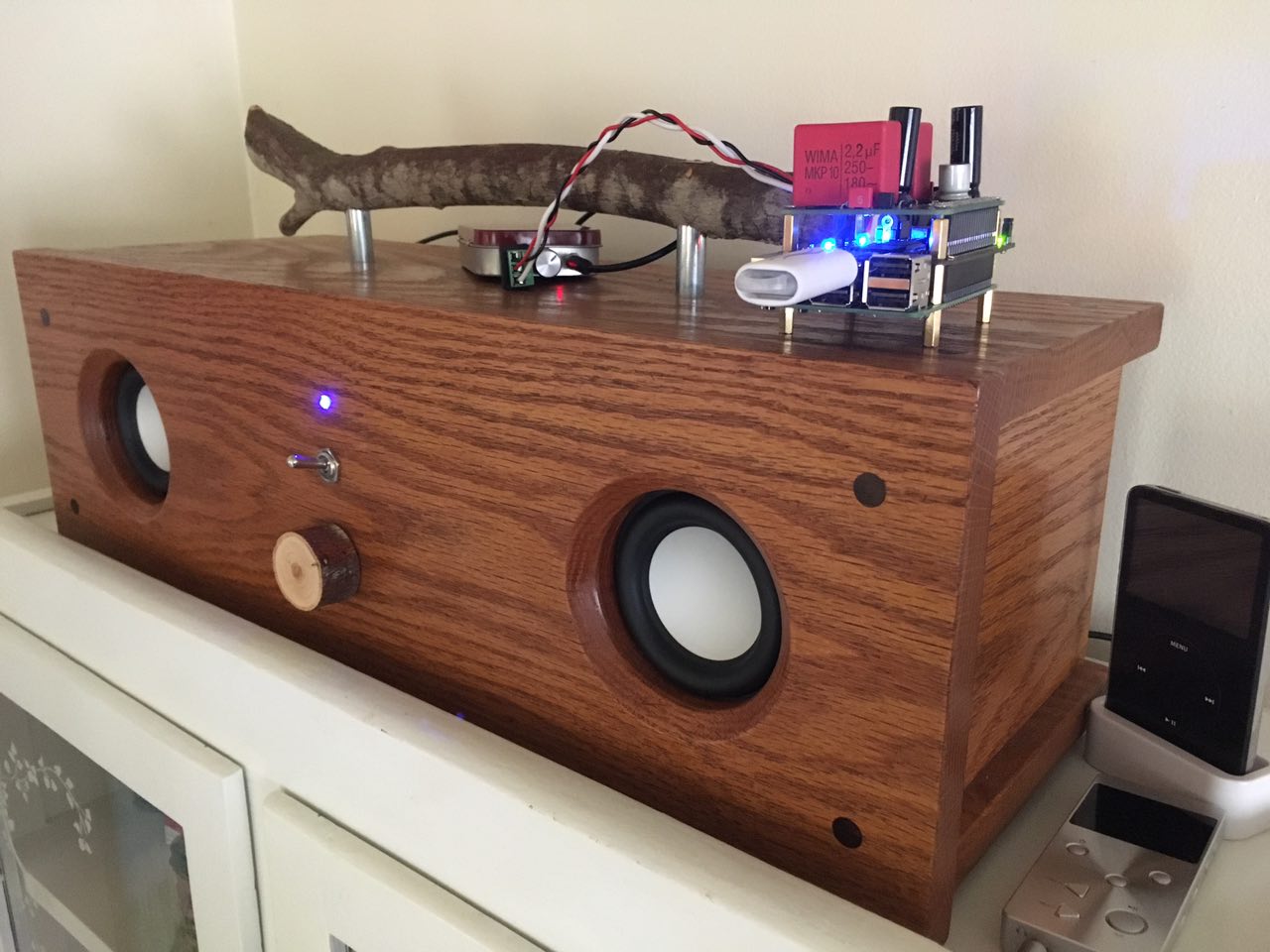
In my Topping/Axiom desktop system, the 1387 surprised me by trouncing not just my X3 but also my Mac’s AKM-equipped Firewire soundcard. The sound was not just smoother, but also had a depth that really drew me into the music much more. The 1387 is as close to wince-free as I have heard. This system is normally quite revealing and analytical—rather lacking warmth and body— and the 1387 hat fleshed out vocals and other instruments with more natural tonal presence. It was over this system that I really noticed the imaging capabilities of the DAC. Voices and instruments seemed to each emerge from a much more distinct “point source” than with my other DACs, which threw a wider overall image but seemed to sort of smear each instrument out wider as well.

Once I my ears adjusted to the 1387, I found its center image much more convincing, and I found myself listening “in” to the music rather than just reacting to the music coming at me. I noticed some 3-D depth to the soundstage that was not present with the other sources. Somewhere I saw somebody describe the NOS sound as presenting music “in repose” as opposed to “in your face.” I totally get it now.
On to the Denon/Opera system (see pic from previous post). Over Easter weekend I convinced my dad to let me hook my Pi stack up to his stereo, which is pretty great to my ears—detailed without harshness, lively and engaging, with more grunt and euphonic warmth than my own Class D setups. His usual source is a 20 year-old Pioneer Elite CD/DVD player, which we ran into the A/B box alongside my DAC (which was warmed up for six hours). While they say that the apple doesn’t fall far from the tree, I was only able to find one disc in his entire music collection that I also have in FLAC—John Mayer’s Continuum. It actually turned out to be a great album for critical listening, since all the instruments are very well recorded. I synced up both players and we listened to several tracks together, switching back and forth.
In this test, one distinctive characteristic of the 1387 stood out clearly to both of us. It seems to present the leading edges of notes in a much slower/softer way…the attack of a snare drum, for instance, has much less of the usual snappy energy presented by Delta Sigma. I feel this softness was compounded by the fact that the DAC seemed to slightly compress the full dynamic range of the source material compared to the livelier dynamics of the CD player. Perhaps this shortcoming would be ameliorated by proper gain staging. My DAC’s output was much quieter than my dad’s CD player, and required the Denon’s volume knob to be bumped up considerably. I tried inserting my Pocket Class A, and was thus able to match the volume, but I actually found that in this powerful and resolving system, the PCA seemed to veil the 1387 hat’s presentation (recall that this is actually a tiny headphone amp, with electrolytics for output coupling, not to mention redundant film input caps and a second volume pot ).
).
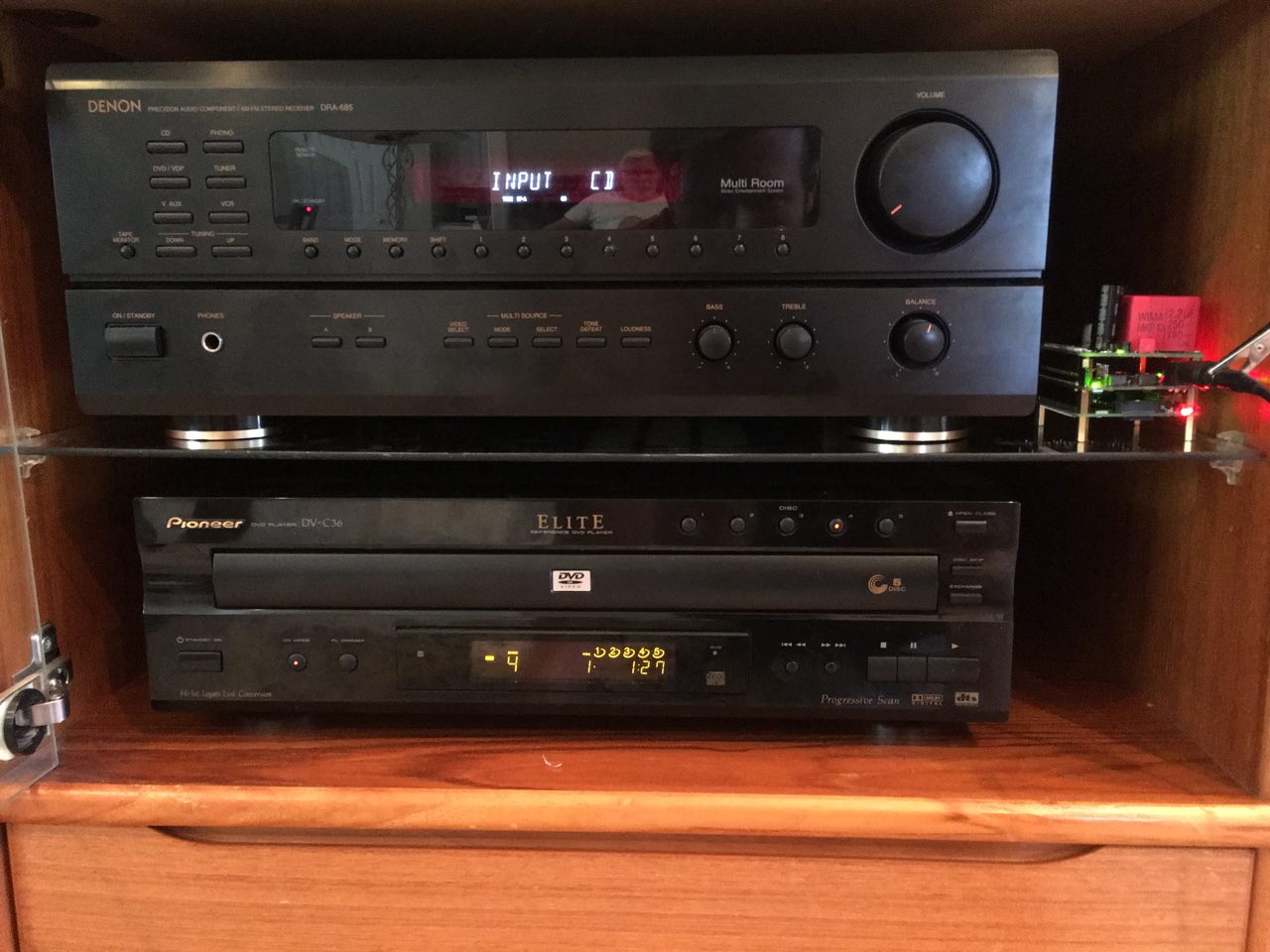
We concluded that the Pioneer player was more fun, engaging, and realistic in my dad’s system. However, this was a $600 player back in its heyday, compared to a sub-$100 Pi stack. Both sources had plenty of body and good overall tone. When we hooked up my X3 player just for grins, the music just collapsed into a cold, 2-D bore. My Dad agreed that the 1387 sounded “good,” but “less clear” than his player. My own personal taste was sort of a toss-up. Though I did prefer the Pioneer’s detail and liveliness, I found the 1387 sound less intrusive as a whole—something I could probably leave on in the background throughout the day at home, without feeling on edge. The Pioneer’s soundstage was much wider throughout the room, owing to its greater treble extension and detail. But when I sat right smack dab in the sweet spot, I found the 1387’s presentation plenty bright, and still “open” and “transparent” and smoothly satisfying, despite its lesser width, microdetail, and punch. Its cohesion, timbre, and solid imaging are really something special.
I have a degree in fine art, not electrical engineering , and I am a graphic designer and teacher by trade. So humor me as I attempt to make a visual analogy to explain how this DAC sounds to me. Perhaps the most oft-used filter in Photoshop is the “unsharp mask”, which artificially increases the apparent focus of an image. Wikipedia has some good examples of its effect. To me, NOS is the original image, and oversampling is the processed image. While the contrast between values is greater, an artificial noise now obscures the subtle tonal balance and true edges of the original lines. Allow me to illustrate this effect by linking some images from Wikipedia:
, and I am a graphic designer and teacher by trade. So humor me as I attempt to make a visual analogy to explain how this DAC sounds to me. Perhaps the most oft-used filter in Photoshop is the “unsharp mask”, which artificially increases the apparent focus of an image. Wikipedia has some good examples of its effect. To me, NOS is the original image, and oversampling is the processed image. While the contrast between values is greater, an artificial noise now obscures the subtle tonal balance and true edges of the original lines. Allow me to illustrate this effect by linking some images from Wikipedia:
Original

Sharpened
In actual use:
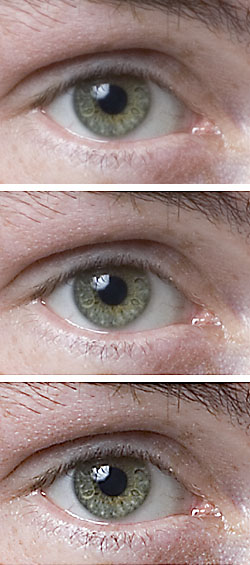
Which is most realistic to you? OK, end of tangent
Some folks compare the NOS sound to steroeptypical analog ease or tube warmth. I think this 1387 hat indeed has a unique sonic character that harkens to both. As such, I think it can provide a very satisfying listening experience for those who specifically desire these traits. Personally, I tend to seek neutrality, but I find that this DAC, especially when paired with equipment that tends toward the fast/analytical/harsh/bright/lean side of the spectrum, conveys the music in a beautiful way that strikes a good balance between realism and musicality. In terms of cost/performance ratio, this thing is easily the best investment I have ever made in hi-fi. It has brought my headphone listening to new heights, and it has opened my ears to the sonic possibilities that exist beyond the world of Sigma Delta chips. Thanks for sharing your creation, Matt.
I won't pretend to have used your 1387 DAC hat to the highest of its capabilities. Still, after listening to it in many sessions and through a handful of systems, I think I am ready to share some reasonably informed impressions of this DAC’s character.
All of my listening has been done with this DAC hat stacked on top of a RPi 3 and Allo Kali, all powered by a single iFi iPower SMPS. I have exclusively used Volumio to play my FLAC collection, which ranges from 16/44 to 26/192, from a USB thumb drive. In all cases, comparisons to other DACs were made with sighted A/B listening. Competing players were synced with identical music and volume matched by ear, both fed into a simple RCA source selector box for instantaneous switching back and forth.
I began by testing the DAC with headphones, since I do a lot of "canned" listening at night while my family is sleeping. Once I grounded the iPower barrel properly (thanks to you all for the hand-holding there) the noise disappeared, and I really fell in love with the sound of the 1387.
Signal chain was:
1387 Hat -> Pocket Class A Headamp -> both Audio Technica M50 and the Fostex T50RP Mk3 w/ Mayflower v1 mod.
IMO it is tougher to achieve a truly satisfying listening experience through headphones than it is through loudspeakers. They are fraught with driver and housing resonances that often color the sound more dramatically than speakers, and their soundstaging abilities are inherently limited by their unnatural placement directly on the head. That said, they eliminate room reflections and thus can offer a very revealing, direct window into the sound of a music source. This DAC has given me more listening pleasure through both of my pairs of headphones than any other source I have owned. It has a somewhat narrower soundstage than I am used to, and it presents a very cohesive center image which brings the music together into a dynamic whole, rather than splitting it apart. This sounds more natural to me, over headphones especially.
The 1387 has a gentle transient attack and a slightly warm but wonderfully nuanced midrange texture. It also has an innately relaxed treble that is not just the result of classic NOS rolloff at the 44.1 sample rate; this softness persists with files sampled up to 192 kHz. Since most headphones (mine included) tend to have glaring frequency response spikes in the treble region, this softness fights treble harshness better than anything else I have yet encountered, making the headphone listening experience infinitely less fatiguing, more organic, and downright pleasurable. Especially over my incisively fast, detailed, and slightly bright Fostex planars, this DAC smooths the sharp edges just enough, and brings a tonal richness that makes these cans sing absolutely gorgeously. For the first time ever, I can listen to entire an entire album through these headphones with satisfaction instead of fatigue.
I also played this DAC over three speaker systems, both with and without my Pocket Class A in the chain as a humble but effective preamp. Since this DAC has a lowish output voltage, I believe it will shine brighter in any system when followed by a high quality dedicated preamp (better than the pocket amp I used).
Three signal chains:
Sure AA-AB32155 (Tripath TA2024) -> Aura NS3 full-rangers (my Carmody “Sprite” Boombox)
Topping TP-20 (Tripath TA2020) -> Axiom M3 bookshelf 2-ways (my nearfield desktop system)
Denon DRA-685 Class AB 100W integrated -> Opera Callas Gold bookshelf 2-ways w/ sub (my dad’s stereo)
Over speakers, the same gentle, pleasant sonic characteristics of the 1387 DAC persist, but may represent a step away from neutrality, towards more of a delicate sonic coloration, compared to most modern DACs (depending on the downstream equipment). I don’t view this as a weakness so much as an important consideration for finding system synergy.
Through my Sure/Aura full-range boombox, I felt that the 1387 DAC hat was a clear step up from the source I usually pair with it—an xDuoo X3 DAP with a Cirrus chip inside. I have always found the X3 to lack midrange fullness and suffer from a metallic treble glare; the 1387 solved these issues handily, exuding a very smooth, sweet, and involving stereo image in the sweet spot. The only downside was that off-axis listening (already subpar because of the directional treble of these full-range drivers) became even warmer and duller than before.
In my Topping/Axiom desktop system, the 1387 surprised me by trouncing not just my X3 but also my Mac’s AKM-equipped Firewire soundcard. The sound was not just smoother, but also had a depth that really drew me into the music much more. The 1387 is as close to wince-free as I have heard. This system is normally quite revealing and analytical—rather lacking warmth and body— and the 1387 hat fleshed out vocals and other instruments with more natural tonal presence. It was over this system that I really noticed the imaging capabilities of the DAC. Voices and instruments seemed to each emerge from a much more distinct “point source” than with my other DACs, which threw a wider overall image but seemed to sort of smear each instrument out wider as well.
Once I my ears adjusted to the 1387, I found its center image much more convincing, and I found myself listening “in” to the music rather than just reacting to the music coming at me. I noticed some 3-D depth to the soundstage that was not present with the other sources. Somewhere I saw somebody describe the NOS sound as presenting music “in repose” as opposed to “in your face.” I totally get it now.
On to the Denon/Opera system (see pic from previous post). Over Easter weekend I convinced my dad to let me hook my Pi stack up to his stereo, which is pretty great to my ears—detailed without harshness, lively and engaging, with more grunt and euphonic warmth than my own Class D setups. His usual source is a 20 year-old Pioneer Elite CD/DVD player, which we ran into the A/B box alongside my DAC (which was warmed up for six hours). While they say that the apple doesn’t fall far from the tree, I was only able to find one disc in his entire music collection that I also have in FLAC—John Mayer’s Continuum. It actually turned out to be a great album for critical listening, since all the instruments are very well recorded. I synced up both players and we listened to several tracks together, switching back and forth.
In this test, one distinctive characteristic of the 1387 stood out clearly to both of us. It seems to present the leading edges of notes in a much slower/softer way…the attack of a snare drum, for instance, has much less of the usual snappy energy presented by Delta Sigma. I feel this softness was compounded by the fact that the DAC seemed to slightly compress the full dynamic range of the source material compared to the livelier dynamics of the CD player. Perhaps this shortcoming would be ameliorated by proper gain staging. My DAC’s output was much quieter than my dad’s CD player, and required the Denon’s volume knob to be bumped up considerably. I tried inserting my Pocket Class A, and was thus able to match the volume, but I actually found that in this powerful and resolving system, the PCA seemed to veil the 1387 hat’s presentation (recall that this is actually a tiny headphone amp, with electrolytics for output coupling, not to mention redundant film input caps and a second volume pot
We concluded that the Pioneer player was more fun, engaging, and realistic in my dad’s system. However, this was a $600 player back in its heyday, compared to a sub-$100 Pi stack. Both sources had plenty of body and good overall tone. When we hooked up my X3 player just for grins, the music just collapsed into a cold, 2-D bore. My Dad agreed that the 1387 sounded “good,” but “less clear” than his player. My own personal taste was sort of a toss-up. Though I did prefer the Pioneer’s detail and liveliness, I found the 1387 sound less intrusive as a whole—something I could probably leave on in the background throughout the day at home, without feeling on edge. The Pioneer’s soundstage was much wider throughout the room, owing to its greater treble extension and detail. But when I sat right smack dab in the sweet spot, I found the 1387’s presentation plenty bright, and still “open” and “transparent” and smoothly satisfying, despite its lesser width, microdetail, and punch. Its cohesion, timbre, and solid imaging are really something special.
I have a degree in fine art, not electrical engineering
Original

Sharpened
In actual use:

Which is most realistic to you? OK, end of tangent
Some folks compare the NOS sound to steroeptypical analog ease or tube warmth. I think this 1387 hat indeed has a unique sonic character that harkens to both. As such, I think it can provide a very satisfying listening experience for those who specifically desire these traits. Personally, I tend to seek neutrality, but I find that this DAC, especially when paired with equipment that tends toward the fast/analytical/harsh/bright/lean side of the spectrum, conveys the music in a beautiful way that strikes a good balance between realism and musicality. In terms of cost/performance ratio, this thing is easily the best investment I have ever made in hi-fi. It has brought my headphone listening to new heights, and it has opened my ears to the sonic possibilities that exist beyond the world of Sigma Delta chips. Thanks for sharing your creation, Matt.
Attachments
Last edited:
stellarelephant - that's quite the write-up, thank you for taking the time to give such a detailed impression. I'm a little overwhelmed!
I'll re-read this and add some more thoughts later. But my initial thoughts are that I think we are more or less on the same page. I know, by looking at this chip's specs, given it's age, and low-cost, with such a simple implementation I don't expect perfection. But there's something about it that just touches me the right way. Someone else used the word "sweet" and that characterization has stuck with me. I too like detailed-yet-neutral, but this chip may provide a bit of coloration that I (and you!) find euphonic.
I didn't do any sophisticated A-B testing between this DAC and the Allo Boss I was previously using. But my gut impression was not dissimilar to your observations; this DAC is perhaps gives up a bit of detail, but replaces with that distinct sweetness.
Now you've convinced me I need to create a headphone rig. Thus far my headphone use has been strictly utilitarian: noise-cancelling cans for the train, and some basic headphones at work to drown out office noise.
Thus far my headphone use has been strictly utilitarian: noise-cancelling cans for the train, and some basic headphones at work to drown out office noise.
At any rate: do you have the ability in any of the rigs you mentioned to take advantage of balanced (XLR) inputs? Again, without doing any kind of formal comparison, I feel the balanced version takes it up a notch. Not dramatic, but definitely an improvement. I built up two, I could send you one as a loaner if you can use it. (I wasn't planning on doing a group buy with the balanced ones, as the BOM cost is higher and they are significantly more work to assemble.)
At any rate, from my personal perspective, my goal of creating an "80-20" DAC (80% of the goodness at 20% the cost/effort) is a success. Sounds like you'd agree with that characterization as well! I created this to "scratch an itch". And while I'd be happy that it works for me, it's delightful to see someone else getting some enjoyment out of it.
I'd say the next step is to grab Abraxalito's "back end" (filter + I/V + buffer). I haven't heard it yet, but my expectations are high.
Thanks again for the write-up!
I'll re-read this and add some more thoughts later. But my initial thoughts are that I think we are more or less on the same page. I know, by looking at this chip's specs, given it's age, and low-cost, with such a simple implementation I don't expect perfection. But there's something about it that just touches me the right way. Someone else used the word "sweet" and that characterization has stuck with me. I too like detailed-yet-neutral, but this chip may provide a bit of coloration that I (and you!) find euphonic.
I didn't do any sophisticated A-B testing between this DAC and the Allo Boss I was previously using. But my gut impression was not dissimilar to your observations; this DAC is perhaps gives up a bit of detail, but replaces with that distinct sweetness.
Now you've convinced me I need to create a headphone rig.
At any rate: do you have the ability in any of the rigs you mentioned to take advantage of balanced (XLR) inputs? Again, without doing any kind of formal comparison, I feel the balanced version takes it up a notch. Not dramatic, but definitely an improvement. I built up two, I could send you one as a loaner if you can use it. (I wasn't planning on doing a group buy with the balanced ones, as the BOM cost is higher and they are significantly more work to assemble.)
At any rate, from my personal perspective, my goal of creating an "80-20" DAC (80% of the goodness at 20% the cost/effort) is a success. Sounds like you'd agree with that characterization as well! I created this to "scratch an itch". And while I'd be happy that it works for me, it's delightful to see someone else getting some enjoyment out of it.
I'd say the next step is to grab Abraxalito's "back end" (filter + I/V + buffer). I haven't heard it yet, but my expectations are high.
Thanks again for the write-up!
I'd borrow your balanced DAC if I could use it, but I don't have any balanced amps. I know that balanced drive doubles the voltage swing and cancels EMI pickup--so it makes sense that you prefer it. My Firewire DAC actually has dual 1/4" balanced TRS outputs but I have never had the equipment to take advantage of it. Perhaps someday I will build a balanced headphone amp and rewire my headphones to hear the difference.
What's the USB interface ...
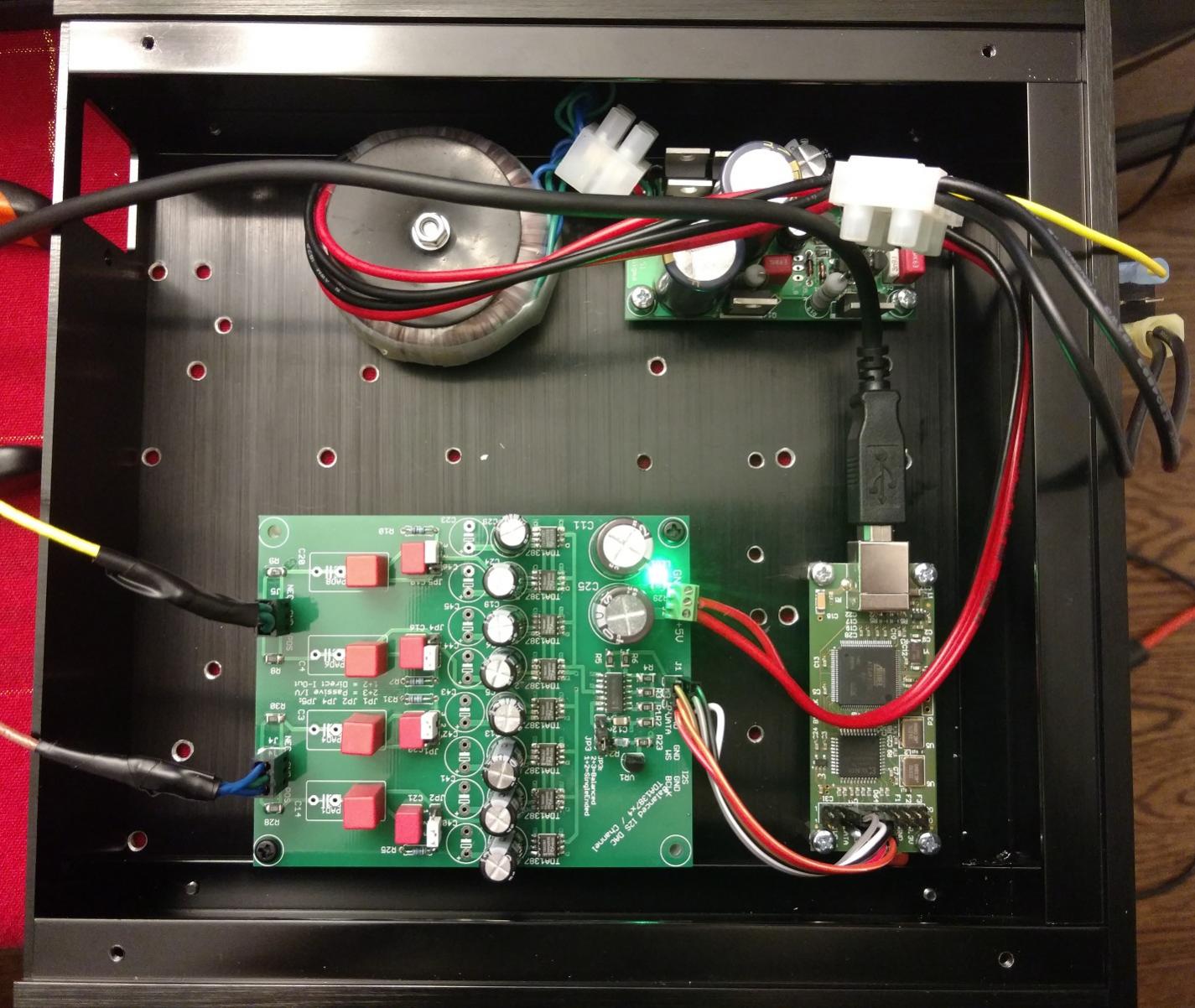
How does it compare to the RPI interface?
What USB (to I2S ???) interface are you using in the lower right?...
Hopefully I'll have time tomorrow to finish the case work. I just need to drill out the real panel.
How does it compare to the RPI interface?
Better than RPI...
Also, the Amanero = $100 USD. How many Pi's can I put in my shopping cart for that dough?
I wonder if that approach is now "old school". That is, now that we're in the age of RPI and OrangePi and the other SBCs?Definitely looks like an Amanero.
Also, the Amanero = $100 USD. How many Pi's can I put in my shopping cart for that dough?
Assuming you don't have need for DSD then the CM6631 is an excellent choice and much, much cheaper : 2017??CM6631 IIS?????????Amanero USB/192K 32BIT-???
1) I buy my TDA1387 from Taobao, here is just one seller : ?? TDA1387 ???????IC?? ??? TDA1387T ????-???
2) The resistor for I/V depends on the supply voltage, let's assume you choose 5V. Then for a single TDA, R = 3.3k; for two TDA R = 1.6k ; four TDA R = 820R; eight TDA R = 390R.
The above is assuming you want the simplest form of I/V, passive I/V. If you go for the single transistor active I/V the resistor value needs to be lower, 2.7k for one TDA.
2) The resistor for I/V depends on the supply voltage, let's assume you choose 5V. Then for a single TDA, R = 3.3k; for two TDA R = 1.6k ; four TDA R = 820R; eight TDA R = 390R.
The above is assuming you want the simplest form of I/V, passive I/V. If you go for the single transistor active I/V the resistor value needs to be lower, 2.7k for one TDA.
Last edited:
I wonder if that approach is now "old school". That is, now that we're in the age of RPI and OrangePi and the other SBCs?
Also, the Amanero = $100 USD. How many Pi's can I put in my shopping cart for that dough?
Yup, it is indeed an Amanero. I've had that for a long time now (it wasn't purchased specifically for this project). Based strictly on hearsay of subjective internet discussions, it seems like the latest XMOS USB-to-I2S is the one to get.
The RPI specifically has limitations on its I2S output that are well-documented. In short, the RPI's oscillator frequency isn't an integer multiple of 44.1 or 48, so jitter is basically guaranteed. How much that jitter matters on an old NOS dac like the tda1387 is up for debate. However, it seems everyone says jitter is a deal-breaker for modern delta sigma dacs.
So with the RPI, people often use something like Allo's Kali reclocker or diyAudio's iancanada has similar boards that "correct" the I2S.
If you go with a bare RPI and are OK with its limitations, then indeed it's one of the cheaper ways to get I2S.
-1- Where to buy the TDA 1387 ?
I've bought all mine off ebay or AliExpress.
Latest USB-to-I2S?
I have no idea what the latest-n-greatest anything is!
Hmmm ...
How about the diyinhk device?

..it seems like the latest XMOS USB-to-I2S is the one to get.
.
I have no idea what the latest-n-greatest anything is!
Hmmm ...
How about the diyinhk device?

- Home
- Source & Line
- Digital Line Level
- tda1387 dac pcb "front end"
